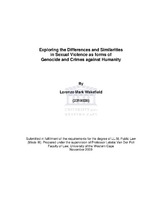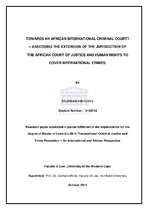| dc.description.abstract | Even though sexual violence has always been a part and parcel of conflicts and atrocities throughout the ages, it never found any interpretation by subsequent tribunals who were responsible for prosecuting offenders.The case of The Prosecutor v Jean-Paul Akayesu was the first of its kind to give jurisprudential recognition and interpretation to sexual violence as war crimes, crimes against humanity and genocide respectively. This case was important for the following
reasons:1. It acknowledged that sexual violence can amount to an act of genocide;
2. It acknowledged that sexual violence can amount to a crime against humanity; and 3. It was the first case to define rape within an international context.Following the case of The Prosecutor v Jean-Paul Akayesu many tribunals gave recognition to the extent of which sexual violence takes place during atrocities by correctly convicting accused for either participating in sexual violence or aiding and abetting to sexual violence. Amidst the various interpretations on what constitutes sexual
violence and how it is defined, the International Criminal Tribunal for the former
Yugoslavia, the International Criminal Tribunal for Rwanda and the Special Court for
Sierra Leone all either conceptualised sexual violence as genocide, war crimes or/ and crimes against humanity.At the same time, the development of sexual violence as either a crime against humanity or a war crime did not end with the courts. The case of The Prosecutor v Jean-Paul Akayesu sparked a fire in the international community, which led to it paying more attention to the place of sexual violence in treaty law. Taking into account that rape is listed as a crime against humanity in both the International Criminal Tribunal for the former Yugoslavia and the International Criminal Tribunal for Rwanda statutes, the Special Court for Sierra Leone and the International Criminal Court statutes both list more than one form of sexual violence as a crime against humanity. It is interesting to note that the latter two treaty developments took place only after the International Criminal Tribunal conceptualised sexual violence as a crime against humanity.Thus apart from merely listing rape as a crime against humanity, the Statute establishing the Special Court for Sierra Leone, states in article 2(g) that sexual slavery, enforced
prostitution, forced pregnancy and any other form of sexual violence constitutes a crime against humanity. The Statute establishing the International Criminal Court states in article 7(1)(g) that rape, sexual slavery, enforced prostitution, forced pregnancy, enforced sterilisation or any other form of sexual violence of comparable gravity constitutes a crime against humanity. The interpretation of these acts is further guided by the ‘Elements of Crimes’ which are annexed to the International Criminal Court statute.Once again it is interesting to note that the ‘Elements of Crimes’ for these acts are similar to how the International Criminal Tribunals (both the former Yugoslavia and Rwanda tribunals) conceptualised various acts of sexual violence.On the other hand, the definition of genocide remained the same as it was defined in the Convention on the Prevention and Punishment of the Crime of Genocide of 1948. This definition does not expressly mention any form of sexual violence as a form of genocide.However, once again, the trial chamber in the case of The Prosecutor v Jean-Paul Akayesu set the benchmark for sexual violence to constitute a form of genocide by way of
interpretation. The definition of genocide did not subsequently change in the Statute
establishing the International Criminal Court.Based on these premises, this thesis attempts to investigate the similarities and differences in sexual violence as a form of both genocide and a crime against humanity,by addressing the following question:What are the essential and practical differences between sexual violence as crimes against humanity and genocide and what is the legal effect of the differences, should there be any? Chapter 1 highlights the historical overview and developments of sexual violence as genocide and crimes against humanity, while chapter 2 investigates how sexual violence can amount to a form of genocide. Chapter 3 assesses the advances made in sexual violence as a crime against humanity, while chapter 4 importantly draws a comparative analysis between sexual violence as genocide and a crime against humanity. Chapter 4 draws this comparison by weighing up four differences and four similarities in sexual
violence as genocide and a crime against humanity.Chapter 5 highlights the conclusion and provides an answer for the research question that is posed above. Here it is concluded that even though there exist multiple differences in sexual violence as crimes against humanity and genocide, there are also multiple similarities which could possibly amount to a better chance for conviction of an accused under a crime against humanity than genocide. Chapter 5 also provide possible recommendations for the consequences that might flow should sexual violence as a crime against humanity be fairly similar to sexual violence as genocide. | en_US |




